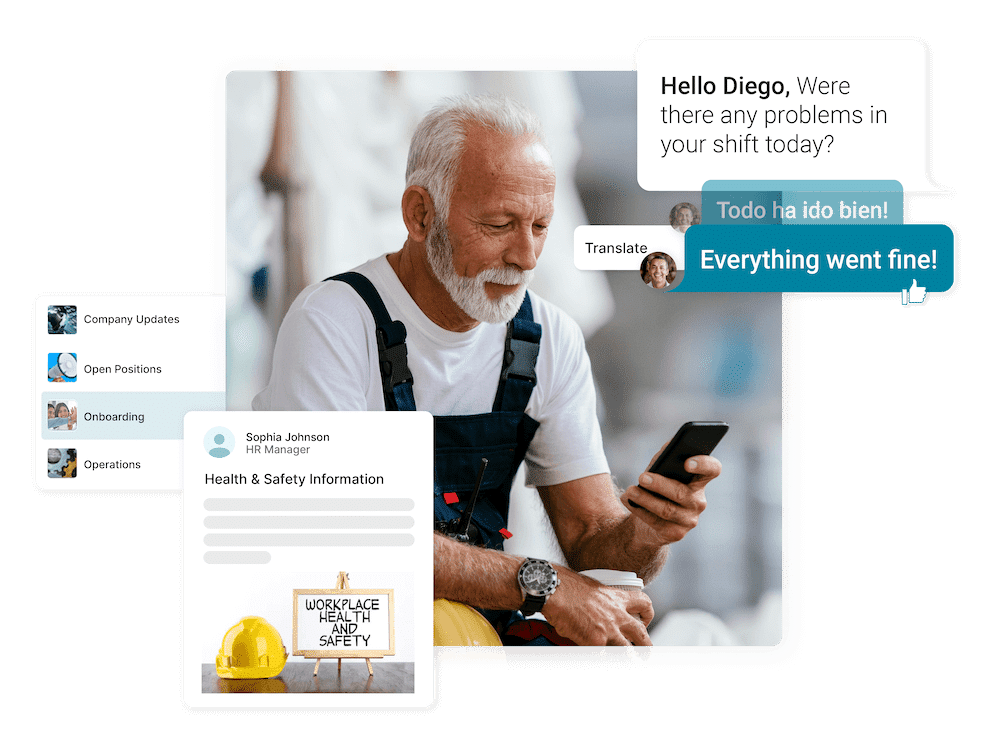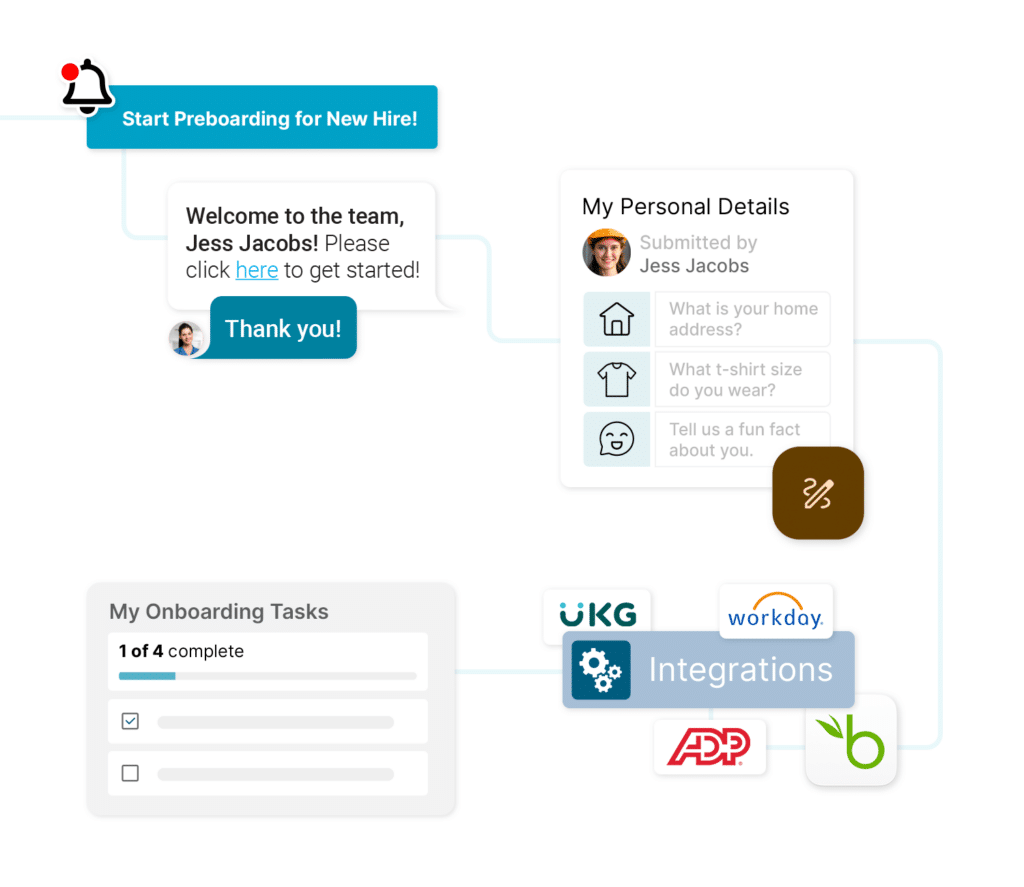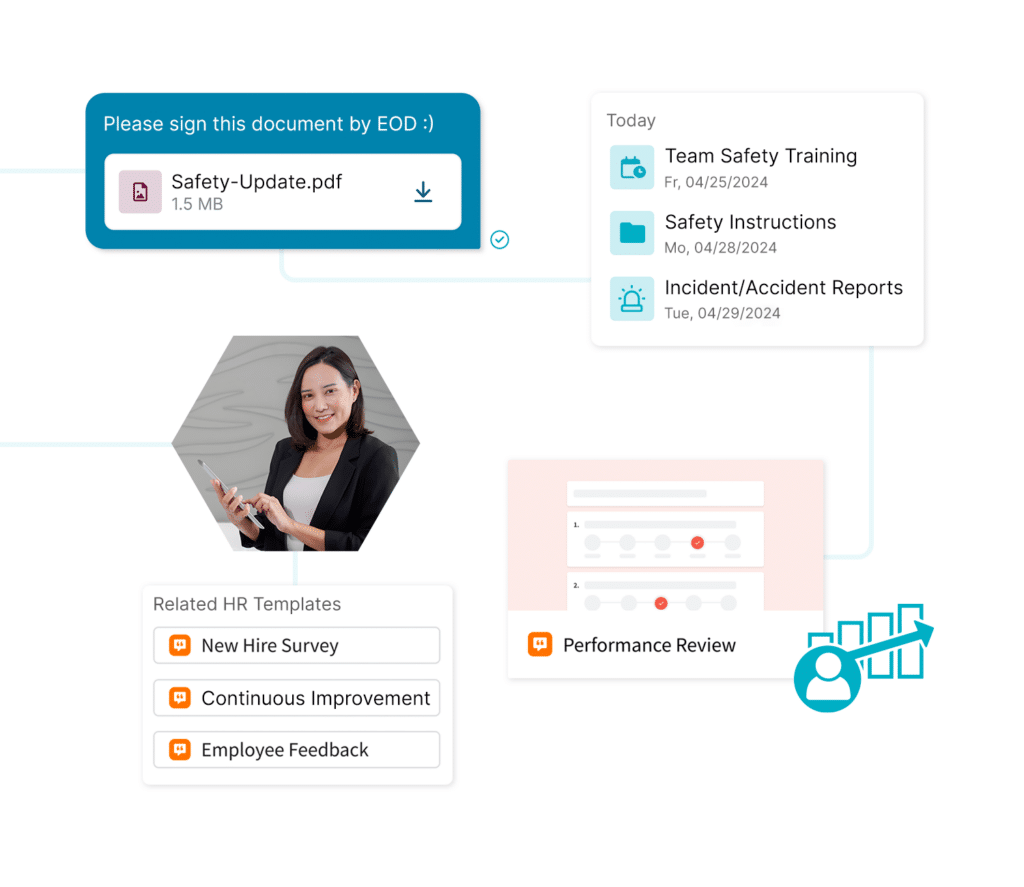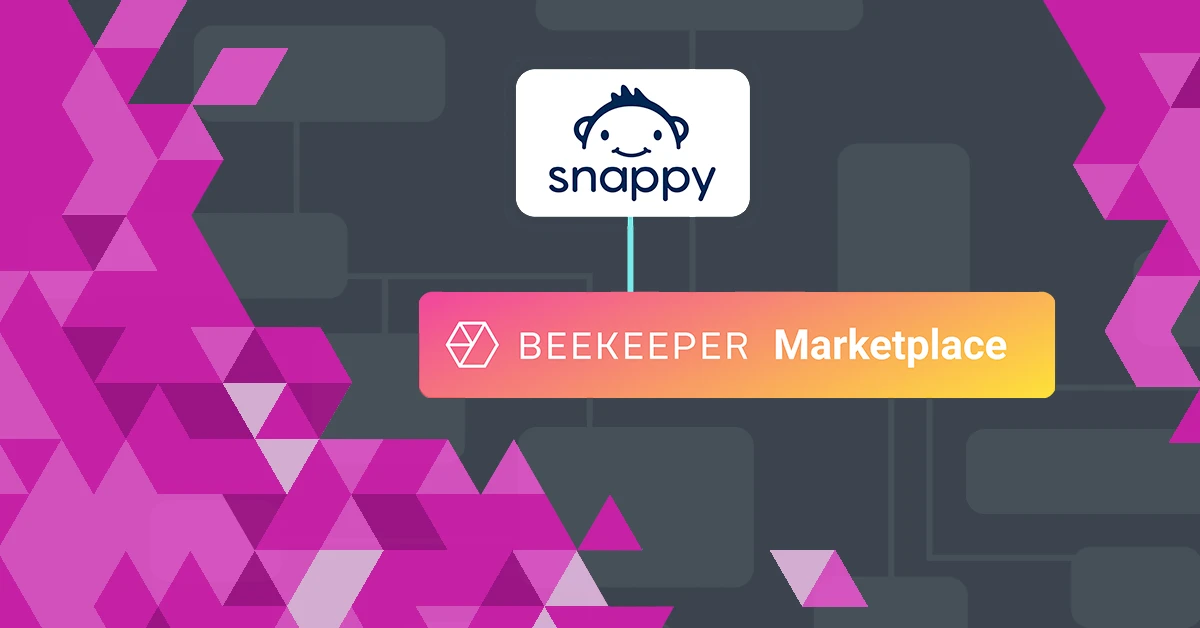Employee Lifecycle Management: Practical Tips for Transforming Your HR Strategy

Table of contents
- What Is The Employee Life Cycle?
- How does an employee lifecycle management process help?
- 9 Stages of the Employee Lifecycle
- 5 Tips to Design an Employee Lifecycle Strategy
- Key KPIs to Track for Employee Lifecycle Effectiveness
- Challenges and Solutions in Employee Lifecycle Management
- The Role of Technology in Enhancing the Employee Lifecycle
- Design Your Employee Lifecycle Model for Optimal Retention
Managing the employee lifecycle, from attraction and recruitment to onboarding, development, retention, separation, and advocacy, can be a complex task.
HR professionals and business leaders often struggle with:
- Ensuring their recruitment and onboarding processes are in line with company objectives
- Adapting to the evolving needs of the workforce while still meeting business targets
- Employee retention and high turnover rates
- Creating an environment that encourages employees to stay and grow within the organization
- Providing adequate development and career advancement opportunities to retain top talent
Inadequate technology integration in HR processes, poor communication and feedback mechanisms, compliance issues, and managing diverse workforce regulations can all make managing the employee lifecycle even more challenging.
We’re here to help with:
- Practical tips for designing an employee lifecycle strategy
- Key KPIs for auditing your employee lifecycle
- Solutions for common employee lifecycle management roadblocks
So, if you are looking to enhance overall employee experience, improve company culture and brand reputation, increase employee engagement and satisfaction, attract and retain top talent, and align HR processes with business objectives, then keep reading. We’ll help empower you to optimize your organization’s success through effective employee lifecycle management.
What Is The Employee Life Cycle?
Before we get there, let’s define the employee life cycle:
The employee life cycle encompasses the stages an individual goes through during their employment. It includes attraction, recruitment, onboarding, development, retention, separation, and advocacy.
Organizations aim to attract suitable candidates, smoothly integrate them through onboarding, enhance their skills through development opportunities, and retain them through engagement efforts.
Eventually, employees may separate due to retirement, resignation, or termination. Maintaining positive relationships with former employees can lead to advocacy and potential rehiring. Managing the employee life cycle is essential for optimizing the workforce and creating a positive employee experience.
How does an employee lifecycle management process help?
Employee lifecycle management is a crucial process that helps organizations maximize the potential of their workforce. By carefully managing each stage of an employee’s journey, from recruitment to exit, businesses can reap benefits like:
- Retaining top talent: An employee lifecycle management process helps organizations retain their top talent by providing development opportunities, recognizing and rewarding achievements, and fostering a positive work environment.
- Recruitment: A well-defined employee lifecycle management process helps attract the right candidates by clearly communicating the organization’s values, culture, and growth opportunities, thereby increasing the likelihood of hiring individuals who align with the organization’s goals.
- Identifying areas of improvement: By closely monitoring each stage of the employee lifecycle, organizations can identify areas where improvements can be made, such as streamlining recruitment processes, enhancing onboarding experiences (maybe with an onboarding checklist), or providing additional training and development programs.
- Enhancing productivity and leverage employee productivity monitoring: A structured employee lifecycle management process ensures that employees have the necessary resources, support, and feedback to perform at their best, resulting in increased productivity and improved overall performance.
- Succession planning: By effectively managing the employee lifecycle, organizations can identify high-potential employees and develop succession plans for key roles, ensuring continuity and minimizing disruptions in case of unexpected departures.
- Employee engagement and satisfaction: A well-implemented employee lifecycle management process focuses on employee engagement and satisfaction, which in turn leads to higher levels of motivation, commitment, and loyalty.
- Cost savings: By reducing turnover rates and attracting top talent, organizations can save costs associated with recruitment, training, and lost productivity due to employee turnover.
- Building a positive employer reputation: An effective employee lifecycle management process helps create a positive employer brand, attracting potential candidates and making the organization an employer of choice in the market.
9 Stages of the Employee Lifecycle
The employee lifecycle encompasses various stages that an individual goes through during their time with an organization. From attraction to advocacy, each stage plays a crucial role in shaping the employee experience. Let’s look at each stage in more detail:
1. Attraction
This stage involves creating a compelling employer brand and attracting potential candidates through effective marketing strategies and compelling job descriptions. It aims to generate interest and excitement about the organization, enticing individuals to consider joining the company.
2. Recruiting
Once potential candidates are attracted, the recruiting stage involves sourcing, screening, and selecting the most suitable candidates for specific job roles (keeping recruiting best practices in mind). It requires comprehensive candidate assessments, interviews, and reference checks to ensure a good fit for both the candidate and the organization.
3. Interviewing
The interviewing stage involves assessing candidates’ skills, qualifications, and cultural fit through various interview techniques such as behavioral or competency-based interviews. It helps determine the candidate’s suitability for the role and their alignment with the organization’s values and objectives.
4. Onboarding
Onboarding is a critical stage that ensures new hires smoothly transition into their roles and the company culture. It involves providing a training plan for new employees and introducing them to their team and organizational processes, helping them feel supported and integrated from day one.
5. Engagement
Employee engagement focuses on creating a positive work environment that fosters motivation, productivity, and job satisfaction. It involves regular communication, recognition programs, and opportunities for employees to voice their opinions, fostering a sense of belonging and commitment.
6. Development
Development opportunities such as training programs, mentorship, and career planning help employees enhance their skills, knowledge, and capabilities. This stage ensures ongoing growth and learning, enabling employees to reach their full potential and contribute effectively to the organization.
7. Retention
Retaining top talent is crucial for an organization’s success. This stage involves implementing strategies to ensure employee satisfaction, addressing their needs, recognizing their contributions, and offering competitive compensation and benefits. It aims to create an environment where employees feel valued and motivated to stay with the company. (Read more about our employee retention program ideas!)
8. Offboarding/Separation
When an employee leaves the organization, the offboarding stage ensures a smooth transition for both the departing employee and the company. It involves conducting exit interviews, handling necessary paperwork, and transferring knowledge to minimize disruption and maintain positive relationships.
9. Advocacy
The final stage involves nurturing relationships with former employees to transform them into brand ambassadors. By maintaining positive connections, providing support, and encouraging them to share their positive experiences, organizations can benefit from their advocacy, attracting potential candidates and enhancing their reputation.
5 Tips to Design an Employee Lifecycle Strategy
Designing an effective employee lifecycle strategy is crucial for organizations to attract, retain, and develop top talent. Here are five tips to consider:
1. Define Clear Objectives
Before designing an employee lifecycle strategy, it is essential to establish clear objectives. These objectives should align with the organization’s overall goals and values. For example, if the company aims to foster a culture of innovation, the employee lifecycle strategy should focus on attracting and retaining creative individuals. Defining clear objectives will help guide the design and implementation of the strategy.
2. Customize to Organizational Needs
Each organization is unique, with different goals, cultures, and challenges. It is crucial to customize the employee lifecycle strategy to fit the specific needs of the organization. This can be achieved by conducting a thorough analysis of the organization’s current state, identifying gaps and areas of improvement, and tailoring the strategy accordingly. A one-size-fits-all approach may not be effective in addressing the specific needs of the organization.
3. Use Technology and Analytics
In today’s digital age, technology and analytics play a crucial role in designing an effective employee lifecycle strategy. Leveraging technology can streamline various HR processes, automate administrative tasks, and enhance communication and collaboration. Additionally, using analytics can provide valuable insights into employee engagement, performance, and satisfaction, enabling organizations to make data-driven decisions and continuously improve the employee experience.
4. Encourage Internal Mobility
Internal mobility refers to the movement of employees within the organization, allowing them to explore different roles, departments, or locations. Encouraging internal mobility can benefit both the organization and the employees. It can enhance employee engagement, motivation, and growth opportunities while also fostering a culture of learning and development within the organization. Designing an employee lifecycle strategy that supports internal mobility can help retain top talent and build a skilled and diverse workforce.
5. Continuous Evaluation and Improvement
An effective employee lifecycle strategy is not a one-time effort but requires continuous evaluation and improvement. It is important to regularly assess the strategy’s effectiveness, gather feedback from employees, and make necessary adjustments to ensure it remains relevant and aligned with the organization’s evolving needs. By continuously evaluating and improving the strategy, organizations can create a positive and engaging employee experience throughout the entire lifecycle.
Designing an employee lifecycle strategy requires careful planning and consideration. By keeping these tips in mind, organizations can create a comprehensive and effective strategy to attract and retain their employees.
Key KPIs to Track for Employee Lifecycle Effectiveness
Tracking key performance indicators (KPIs) is crucial to measure the effectiveness of an employee lifecycle strategy. Here are some important KPIs to consider, along with industry benchmarks for each:
Time-to-Fill for Vacant Positions
This KPI measures the time it takes to fill a vacant position. The industry benchmark for this metric varies depending on the role and industry. However, a general benchmark is around 45-60 days. It is important to monitor and reduce this metric to ensure a smooth hiring process and minimize productivity gaps.
Employee Turnover Rate
This KPI measures the percentage of employees who leave the organization voluntarily or involuntarily. The industry benchmark for turnover rate varies by industry and job level. However, a benchmark of 10-15% is considered healthy for most industries. Monitoring this metric helps identify areas of concern and take corrective actions to reduce employee turnover.
Cost Per Hire
This KPI measures the overall cost incurred to hire a new employee. The industry benchmark for cost per hire is around $4,000-$5,000 per hire. Monitoring and optimizing this metric helps organizations manage recruitment budgets effectively.
New Hire Attrition Rate
This KPI measures the percentage of new hires who leave the organization within a specified period, typically the first year. The industry benchmark for new hire attrition rate varies by industry. However, a benchmark of less than 10% is considered desirable. Tracking this metric helps evaluate the effectiveness of the onboarding process and improve new hire retention.
Employee Engagement Scores
This KPI measures the level of employee engagement and satisfaction within the organization. The industry benchmark for employee engagement scores can vary. However, a benchmark of 75% or higher is considered favorable. Monitoring and improving employee engagement scores contribute to higher productivity, lower turnover, and better overall organizational performance.
Training Return on Investment (ROI)
This KPI measures the impact and effectiveness of training programs. The industry benchmark for training ROI can vary significantly. However, a benchmark of 100% or higher suggests that the training program is generating a positive return. Tracking this metric helps evaluate the effectiveness of training initiatives and make informed decisions regarding training investments.
Employee Net Promoter Score (eNPS)
This KPI measures the likelihood of employees recommending the organization as a place to work. The industry benchmark for eNPS can vary, but a benchmark of 10-30% is generally considered good. Monitoring this metric helps assess employee satisfaction and loyalty, as well as identify areas for improvement in the employee experience.
By tracking these KPIs and comparing them to industry benchmarks, organizations can gain valuable insights into the effectiveness of their employee lifecycle strategy and make data-driven decisions to improve overall performance and engagement.
Challenges and Solutions in Employee Lifecycle Management
Let’s look at five common roadblocks in employee lifecycle management and how to overcome them:
1. Aligning Employee Goals with Organizational Objectives
One challenge in employee lifecycle management is ensuring that individual employee goals are aligned with the overall objectives of the organization. To address this, organizations can implement a performance management system that encourages regular communication between managers and employees to set meaningful goals. This can be coupled with regular performance reviews and feedback sessions to track progress and make necessary adjustments.
2. Adapting to a Diverse Workforce
With the increasing diversity in the workforce, managing and accommodating different needs and perspectives can be a challenge. A solution to this challenge is to foster an inclusive work environment where diversity is celebrated and valued. Organizations can provide diversity training programs, establish employee resource groups, and promote diversity in leadership positions. This will help create an environment where all employees feel respected, included, and motivated to contribute their best.
3. Balancing Automation and Personal Touch
With the rise of technology and automation, striking the right balance between using technology to streamline processes and maintaining a personal touch is crucial. Organizations can leverage technology for administrative tasks, such as onboarding and benefits enrollment, while ensuring that face-to-face interactions and personalized support are still available. Regular check-ins, team-building activities, and mentorship programs can help maintain human connection and foster a positive work environment.
4. Managing Employee Wellness and Burnout
Employee wellness and burnout have become significant concerns in today’s fast-paced work environment. Organizations can address this challenge by seeking to improve work-life balance, offering flexible work arrangements, and providing wellness programs. Encouraging employees to take breaks, setting realistic goals, and promoting stress management techniques can also help prevent burnout and improve employee well-being.
5. Retaining and Developing Talent
Retaining top talent and providing opportunities for growth and development is crucial for successful employee lifecycle management. Organizations can implement career development plans, provide training and development programs, and offer opportunities for employees to take on new challenges and responsibilities. Regular performance discussions and succession planning can also help identify high-potential employees and create tailored development plans to keep them engaged and motivated.
By addressing these challenges and implementing effective solutions, organizations can enhance their employee lifecycle management strategies, leading to improved employee experience and productivity.
The Role of Technology in Enhancing the Employee Lifecycle
Technology plays an essential role in enhancing the employee lifecycle. It streamlines processes, increases productivity, and improves communication and collaboration within an organization.
At Beekeeper, we’ve made it our mission to help frontline organizations optimize the employee lifecycle. Let’s look at four ways Beekeeper does this:
- Communication and Collaboration: With its intuitive interface and user-friendly features, Beekeeper helps frontline employees stay connected and informed in real time. Whether it’s sharing important updates, disseminating company news, or facilitating team collaboration, Beekeeper provides a centralized platform for effective communication. By improving communication, Beekeeper helps foster a sense of community and engagement among employees, ultimately enhancing their experience throughout the employee lifecycle.

- Mobile Accessibility and Workforce Engagement: With a mobile-first approach, Beekeeper ensures that even non-desk employees can easily access and engage with the platform. By providing a seamless mobile experience, Beekeeper enables employees to stay connected and engaged, regardless of their location or role. This accessibility fosters inclusivity and ensures that all employees have access to important information and can actively participate in the organization’s activities.
- Facilitating Feedback and Surveys: Beekeeper allows organizations to engage hourly workers and gather real-time feedback, enabling them to promptly address any concerns or issues that may arise. By providing a platform for open and transparent communication, Beekeeper helps create a culture of trust and continuous improvement. Employees feel empowered to share their thoughts, ideas, and concerns, knowing that their feedback is valued and acted upon. This not only improves the employee experience but also helps drive positive changes within the organization.
- Streamlining Resource Sharing for Development and Training: Beekeeper serves as a centralized hub for distributing resources, information, and training materials, supporting the onboarding process and ongoing development of employees. With Beekeeper, organizations can be sure that employees have access to the necessary tools and information to excel in their roles. This streamlines the training process, saves time, helps reduce cost of onboarding, and fosters a culture of continuous learning and development.
With Beekeeper as a communication and collaboration tool, frontline organizations can create a more efficient and productive workplace, ultimately enhancing the overall employee lifecycle.
Design Your Employee Lifecycle Model for Optimal Retention
Creating a solid employee lifecycle model is crucial for managing and retaining talent and fostering a positive work environment. It’s all about crafting a journey that engages and supports employees throughout their time with the company. Here are a few tips:
- Start with a strong onboarding process: This is where first impressions are made, and you want to make them count. Provide new hires with a warm welcome, clear expectations, and the necessary tools to succeed. A well-structured onboarding program with an employee onboarding checklist sets the tone for a positive employee experience from day one.
- Focus on continuous learning and development opportunities: Employees crave growth and advancement, so make sure you offer them the chance to learn new skills, attend workshops, or participate in mentorship programs. By investing in their professional development, you show that you’re committed to their success and growth within the company.
- Give regular performance feedback: Don’t wait for annual reviews to provide feedback. Offer ongoing employee feedback surveys and recognition to keep employees engaged and motivated. Regular check-ins help identify areas for improvement and celebrate achievements, fostering a culture of continuous improvement.
- Prioritize work-life balance and employee well-being: Offer flexible work arrangements, wellness programs, or mental health support. Creating a supportive and inclusive work environment where employees feel valued and cared for will contribute to their overall satisfaction and retention.
- When it’s time for an employee to move on, make sure to conduct exit interviews: This provides valuable insights into their experience and allows you to identify areas for improvement. Consider adopting an employee offboarding checklist to learn from departures and make necessary adjustments to enhance future employees’ experiences.
Designing an employee lifecycle model for optimal retention requires a holistic approach. Focus on creating a supportive and engaging environment throughout every stage of the employee journey, and you’ll be well on your way to building a team that sticks around for the long haul.
Want to optimize your HR strategy and maximize employee success? Learn more about the power of employee engagement with Beekeeper and how it can revolutionize your frontline organization.

About the author
Stacie Pahl













